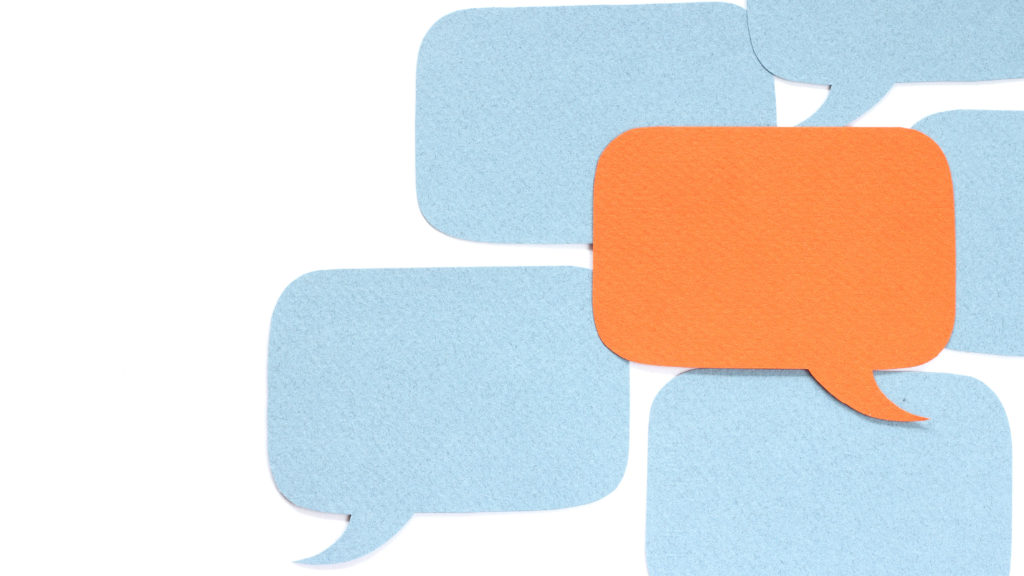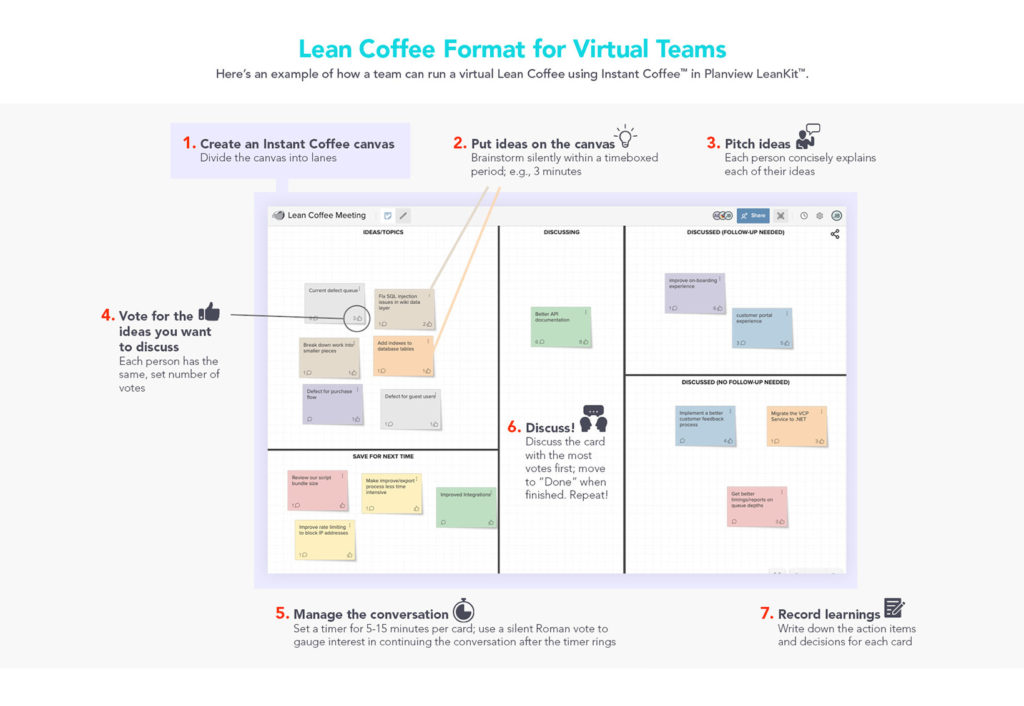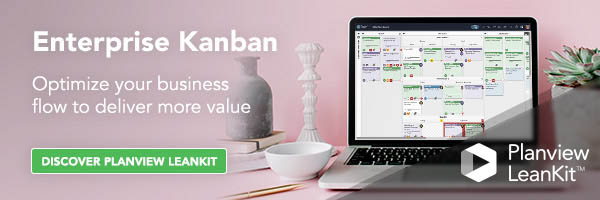
What is a Lean Coffee?
The Lean Coffee format is a structured, but agenda-less, meeting designed to facilitate collaborative group discussions. “How can you have structure without an agenda?” you might ask. Allow me to explain.
Seattle-based Lean thinkers Jim Benson and Jeremy Lightsmith are credited with the invention of Lean Coffee. They wanted to start a regular discussion group for fellow Lean enthusiasts, but without the hassle of finding and scheduling speakers, setting agendas each week, etc. that this kind of meetup usually requires.
Jeremy and Jim wanted their new group format to be Lean enough that the only requirement for a successful meetup was that people showed up willing to participate. (And perhaps a few sticky notes and pens…. And ideally, some good coffee.) They also wanted the format of the meeting to actively encourage participation.
And so, the Lean Coffee format was born. Fast forward a decade or so, and now the Lean Coffee format is being used for much more than just discussing Lean. Lean Coffee is an engaging, collaborative way to brainstorm ideas, conduct planning sessions, and facilitate retrospectives with a group.

Lean Coffee Format Explained
The Lean Coffee format is simple by design: Participants gather (virtually or in-person), pitch ideas to discuss, vote on which ideas to discuss, and then discuss them. At Planview, we use this format to facilitate brainstorms, planning sessions, and retrospectives. We like it so much, we even designed a feature within Planview LeanKitTM called Instant CoffeeTM specifically for holding Lean Coffees (more on that later).
The first step to holding a Lean Coffee is to determine the purpose of the meeting: Whether it’s to brainstorm ideas for new product features, glean learnings from a recently completed project, or plan out next quarter’s big initiatives.
Once you have a purpose in mind, make sure to invite anyone who would be interested in weighing in, or who might be impacted by the outcomes of the discussion. The goal of this very democratic meeting format is to elevate the voices of everyone involved in a particular process — and that starts by making sure they are in the (physical or virtual) room.
1. Create a simple Kanban board
To start your Lean Coffee, you’ll want to create a simple Kanban board. It can be as simple as having three lanes: “To Discuss,” “Discussing,” and “Discussed.”
Everyone needs to be able to see this board, and ideally, be able to add to it. One of the best things about the Lean Coffee format is that it gives people who might not usually be as vocal to contribute their ideas in a quieter, more introvert-friendly way. If only one person is able to modify or add to the board, you run the risk of silencing those voices.
2. Put ideas on the board
Once your board is set up and everyone has access to it, it’s time to start generating ideas. Set a timer for a few minutes to allow everyone to add ideas to the board. Whether you’re using a physical or virtual Kanban board, the idea is the same: One idea per “sticky note,” or card.
Before you start your timer, make sure to align around how to fill out cards: Include enough information to communicate the idea, but not so much that it slows you down. If you’re brainstorming ways to improve your app’s design, for example, “button” might not be specific enough to spark a discussion, but “larger/clearer buttons on every screen” should.
When your timer goes off, do a quick poll to see if the group is ready to discuss. If your participants still have ideas flowing, don’t stop them — ideas are the lifeblood of the Lean Coffee format! Add more time to the clock and reassess once it is done.

3. Pitch ideas
Now that you have ideas on the board, it’s time to review them. The facilitator can read each card, or you can invite participants to explain the cards they added. Edit card titles as necessary during this time to aid in understanding and minimize confusion.
During this time, the facilitator should seek to group related ideas together to make the conversation more efficient. If two or more cards seem to be centered on the same topic, ask the group whether the cards should be consolidated (“Are these two topics the same?”), or if they are unique enough to stand on their own.
4. Vote for the ideas you want to discuss
Once all the cards have been pitched, it’s time to put them to a vote. There are a few ways to do this in a Lean Coffee format:
- For in-person sessions with a physical board and sticky notes, participants can use dot voting: Either drawing dots on cards or adding small stickers to cast their votes.
- On digital Kanban boards, participants can assign themselves to cards as a way of casting their votes.
- In Instant Coffee, participants can vote by adding a “thumbs up” to cards they’d like to vote on.
Determine how many cards each participant is allowed to vote on, and how many votes a card will need in order to be discussed.
5. Manage the conversation
When the voting period is over, introduce the conversation ground rules. Some of the most effective guidelines for the Lean Coffee format involve timed discussions and letting the group decide whether or not to continue discussing a topic. Here’s how.
Select a time limit for discussing each “winning” card, and use a timer to enforce the limit. At the end of the time limit, have participants give either a “thumbs up” (to indicate that they are ready to move on to the next topic), or a “thumbs down” (to indicate that they would like more time to discuss).
When you’re following a Lean Coffee format, it can be helpful to have one person serving as the discussion moderator/facilitator, and another taking notes during the discussion. (Pro tip: Record notes about each card on that card!)
6. Discuss
Now that the group knows the ground rules, it’s time to discuss the cards on your board. First, sort the cards by number of votes. Begin your discussion with the card with the most votes, and then work your way down. Move the cards to “Discussed” when you’ve completed the conversation.
7. Record learnings/determine action items
Once you’ve gone through all the cards, wrap up your Lean Coffee by discussing next steps for the ideas that were discussed. If you used a virtual Kanban board to facilitate your discussion, assign each card to the person responsible for the action items and move it onto their execution/team board.
Tips for Virtual Lean Coffee Facilitators
The Lean Coffee format was originally designed for in-person meetings, but it can be adapted for virtual sessions. Through the power of video conferencing and the Instant Coffee feature within LeanKit, you can have productive and engaging conversations no matter where your participants are.
Here are some tips for facilitating a successful virtual Lean Coffee:
- In your calendar invite for the meeting, include the quick-share link to the Instant Coffee canvas, in addition to the Zoom/other video conferencing link
- Encourage participants to familiarize themselves with Instant Coffee and the Lean Coffee format before the session
- Invite participants to start adding cards to the canvas before the meeting
- Start the session with a quick overview of the Lean Coffee format
- Make sure participants are aware of the many ways they can contribute to the conversation: Speaking aloud or adding comments or questions to their cards or others’ cards
- Remember that your role as a facilitator is to keep the conversation focused and moving, not necessarily to talk the most!
Get Your Ideas Brewing!
Ready to try the Lean Coffee format for your next virtual brainstorming or planning session or retrospective? You have a few options:
- If you’re a Planview customer with access to LeanKit, then it’s as easy as creating a new Instant Coffee canvas directly from your team’s LeanKit board. If you don’t have access to Instant Coffee, then you can contact your account administrator, your Planview representative, or Planview support to learn how to get access.
- If you aren’t (yet!) a Planview LeanKit customer, there are other digital Kanban tools online that can be used to facilitate a Lean Coffee.
- And then of course, if you are co-located with your team, you can do it the old-fashioned way, with a whiteboard and sticky notes.
I’m passionate about the Lean Coffee format because I’ve seen how it can unlock deeper creativity, collaboration, and engagement in teams. If you’ve been looking for a better way to get your ideas brewing, give Lean Coffee a try!




